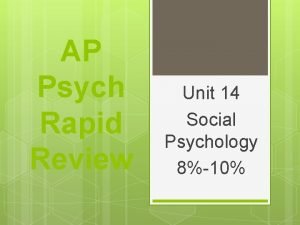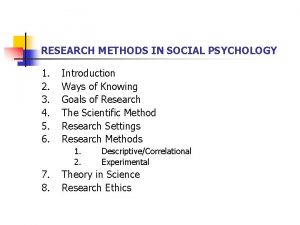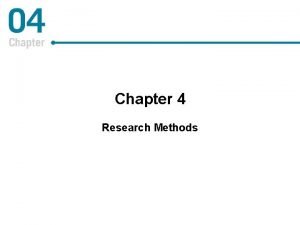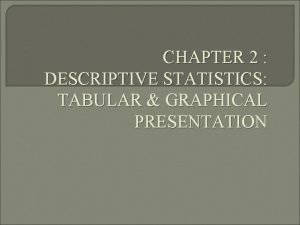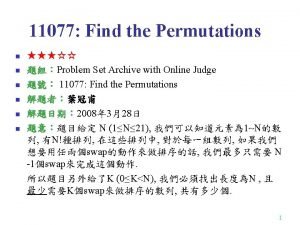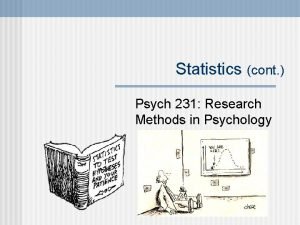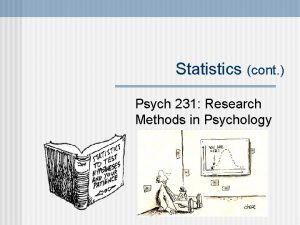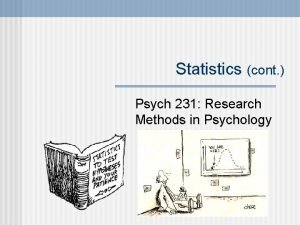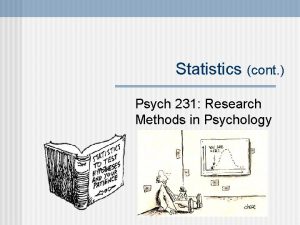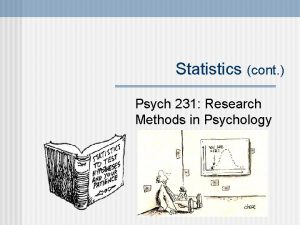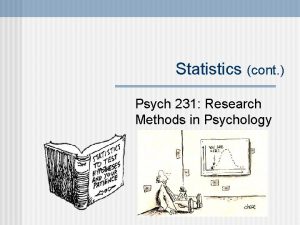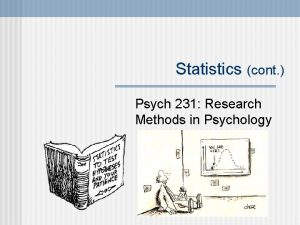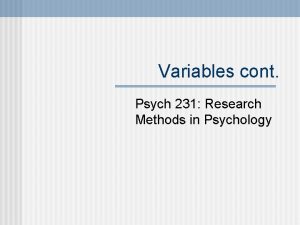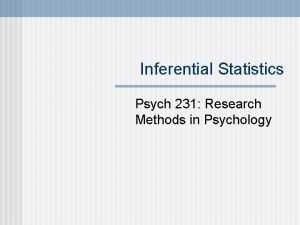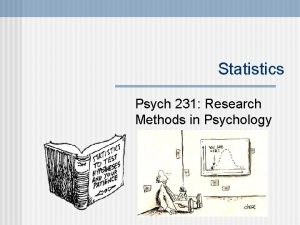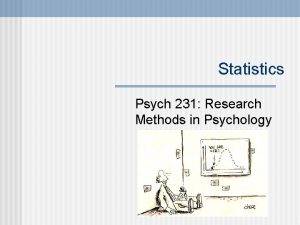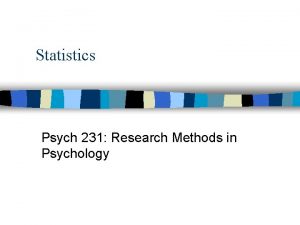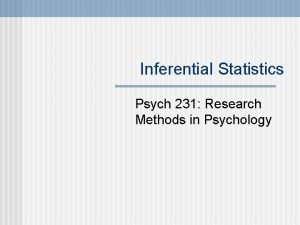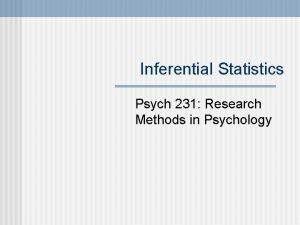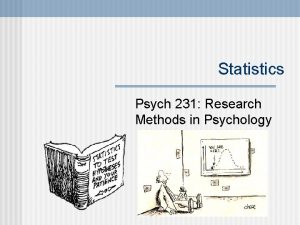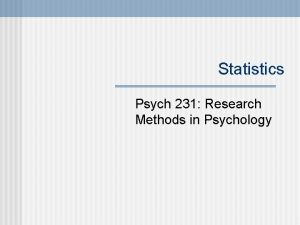Statistics cont Psych 231 Research Methods in Psychology




















- Slides: 20

Statistics (cont. ) Psych 231: Research Methods in Psychology

n Due today n n Journal Summary 2 assignment Descriptive and inferential statistics exercises Class experiment final draft (Adam’s sections) No labs this week n Use your time to work on posters of the group projects • Poster sessions are last lab sections of the semester (last week of classes), so start thinking about your posters. I will lecture about poster presentations on Monday. Announcements

n n n Step 1: State your hypotheses Step 2: Set your decision criteria Step 3: Collect your data from your sample(s) Step 4: Compute your test statistics Step 5: Make a decision about your null hypothesis n “Reject H 0” – there is a statistically significant difference n “Fail to reject H 0” – there is not a statistically significant difference Testing Hypotheses

XA n n XB ER: Random sampling error ID: Individual differences (if between subjects factor) TR: The effect of a treatment The generic test statistic - is a ratio of sources of variability TR + ID + ER Observed difference Computed = = test statistic Difference from chance ID + ER “Generic” statistical test

Population Distribution of sample means Sample σ s μ “chance” X Avg. Sampling error Difference from chance

n The generic test statistic distribution n To reject the H 0, you want a computed test statistics that is large • reflecting a large Treatment Effect (TR) n What’s large enough? The alpha level gives us the decision criterion Distribution of the test statistic TR + ID + ER Test statistic Distribution of sample means α-level determines where these boundaries go “Generic” statistical test

n The generic test statistic distribution n To reject the H 0, you want a computed test statistics that is large • reflecting a large Treatment Effect (TR) n What’s large enough? The alpha level gives us the decision criterion Distribution of the test statistic Reject H 0 2. 5% “two-tailed” with α = 0. 05 2. 5% Fail to reject H 0 “Generic” statistical test

n The generic test statistic distribution n To reject the H 0, you want a computed test statistics that is large • reflecting a large Treatment Effect (TR) n What’s large enough? The alpha level gives us the decision criterion Distribution of the test statistic Reject H 0 “One tailed test”: sometimes you know to expect a particular difference (e. g. , “improve memory performance”) “one-tailed” with α = 0. 05 5. 0% Fail to reject H 0 “Generic” statistical test

n Things that affect the computed test statistic n Size of the treatment effect • The bigger the effect, the bigger the computed test statistic n Difference expected by chance (sample error) • Variability in the population • Sample size TR + ID + ER “Generic” statistical test

n 1 factor with two groups n T-tests • Between groups: 2 -independent samples • Within groups: Repeated measures samples (matched, related) n 1 factor with more than two groups n n Analysis of Variance (ANOVA) (either between groups or repeated measures) Multi-factorial n Factorial ANOVA Some inferential statistical tests

n Design n n 2 separate experimental conditions Degrees of freedom • Based on the size of the sample and the kind of t-test n Formula: Observed difference T= X 1 - X 2 Diff by chance Computation differs for between and within t-tests T-test Based on sample error

n Reporting your results n n n The observed difference between conditions Kind of t-test Computed T-statistic Degrees of freedom for the test The “p-value” of the test n “The mean of the treatment group was 12 points higher than the control group. An independent samples t-test yielded a significant difference, t(24) = 5. 67, p < 0. 05. ” n “The mean score of the post-test was 12 points higher than the pre -test. A repeated measures t-test demonstrated that this difference was significant, t(12) = 5. 67, p < 0. 05. ” T-test

n Designs n XA XB XC More than two groups • 1 Factor ANOVA, Factorial ANOVA • Both Within and Between Groups Factors n n Test statistic is an F-ratio Degrees of freedom n n Several to keep track of The number of them depends on the design Analysis of Variance

XA n XB XC More than two groups n n Now we can’t just compute a simple difference score since there are more than one difference So we use variance instead of simply the difference • Variance is essentially an average difference F-ratio = Observed variance Variance from chance Analysis of Variance

XA n XB XC 1 Factor, with more than two levels n Now we can’t just compute a simple difference score since there are more than one difference • A - B, B - C, & A - C 1 factor ANOVA

Null hypothesis: XA XB H 0: all the groups are equal XA = X B = X C Alternative hypotheses HA: not all the groups are equal XA ≠ X B ≠ X C XA = X B ≠ X C 1 factor ANOVA XC The ANOVA tests this one!! Do further tests to pick between these XA ≠ X B = X C XA = X C ≠ X B

Planned contrasts and post-hoc tests: - Further tests used to rule out the different Alternative hypotheses XA ≠ X B ≠ X C Test 1: A ≠ B Test 2: A ≠ C Test 3: B = C XA = X B ≠ X C XA ≠ X B = X C XA = X C ≠ X B 1 factor ANOVA

n Reporting your results The observed differences n Kind of test n Computed F-ratio n Degrees of freedom for the test n The “p-value” of the test n Any post-hoc or planned comparison results “The mean score of Group A was 12, Group B was 25, and Group C was 27. A 1 -way ANOVA was conducted and the results yielded a significant difference, F(2, 25) = 5. 67, p < 0. 05. Post hoc tests revealed that the differences between groups A and B and A and C were statistically reliable (respectively t(1) = 5. 67, p < 0. 05 & t(1) = 6. 02, p <0. 05). Groups B and C did not differ significantly from one another” n n 1 factor ANOVA

n n We covered much of this in our experimental design lecture More than one factor n n n Factors may be within or between Overall design may be entirely within, entirely between, or mixed Many F-ratios may be computed n n An F-ratio is computed to test the main effect of each factor An F-ratio is computed to test each of the potential interactions between the factors Factorial ANOVAs

n Reporting your results n The observed differences • Because there may be a lot of these, may present them in a table instead of directly in the text n Kind of design • e. g. “ 2 x 2 completely between factorial design” n Computed F-ratios • May see separate paragraphs for each factor, and for interactions n Degrees of freedom for the test • Each F-ratio will have its own set of df’s n The “p-value” of the test • May want to just say “all tests were tested with an alpha level of 0. 05” n Any post-hoc or planned comparison results • Typically only theoretically interesting comparisons are presented Factorial ANOVAs
 Debriefing report
Debriefing report Cont or cont'd
Cont or cont'd Classical conditioning
Classical conditioning Social loafing ap psychology definition
Social loafing ap psychology definition Research methods in social psychology
Research methods in social psychology Research methods in developmental psychology
Research methods in developmental psychology Research methods in abnormal psychology
Research methods in abnormal psychology Ocr psychology research methods
Ocr psychology research methods Critical thinking chapter 2 answers
Critical thinking chapter 2 answers Introduction to statistics what is statistics
Introduction to statistics what is statistics Descriptive statistics numerical measures
Descriptive statistics numerical measures Sampling methods statistics
Sampling methods statistics Tabular presentation of quantitative data
Tabular presentation of quantitative data Wax pattern in dentistry
Wax pattern in dentistry Acf 231
Acf 231 Article 231 of the treaty of versailles
Article 231 of the treaty of versailles 123 132 213 231 312 321
123 132 213 231 312 321 Pa msu
Pa msu Color 21112007
Color 21112007 Hino 231 letra
Hino 231 letra Gezang 231
Gezang 231



